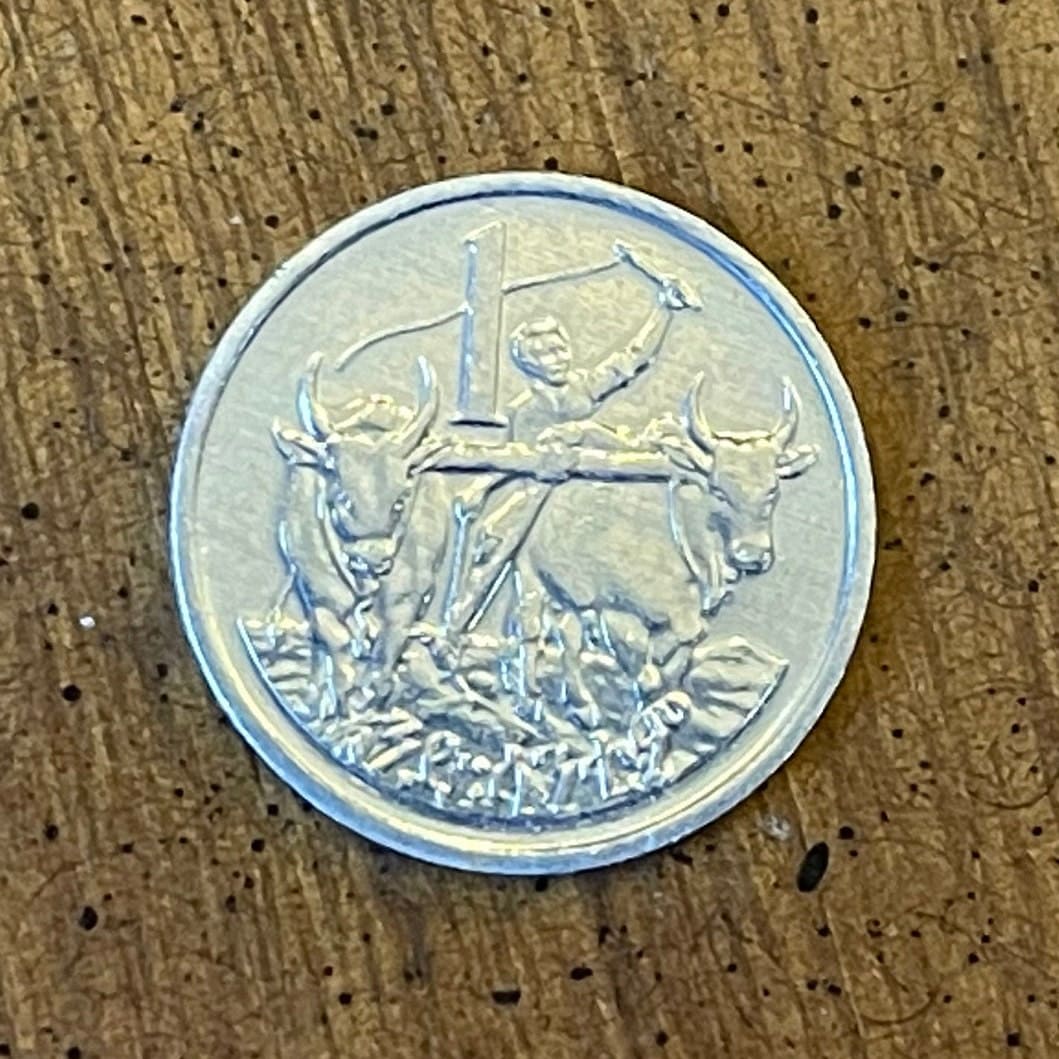elemintalshop
Lion of Judah & Oxen with Farmer Ethiopia 1 Santeem Authentic Coin Money for Jewelry and Craft Making (Rastafarian)
Lion of Judah & Oxen with Farmer Ethiopia 1 Santeem Authentic Coin Money for Jewelry and Craft Making (Rastafarian)
Couldn't load pickup availability
Lion of Judah & Oxen with Farmer Ethiopia 1 Santeem Authentic Coin Charm for Jewelry and Craft Making
Obverse:
Roaring Ethiopian lion bust facing right (Large head, uniform whiskers). Date below
Lettering:
ኢትዮጵያ
፲፱፻፷፱
Translation:
Ethiopia
Date (e.g. 1977)
Reverse: Pair of Oxen and Farmer
Lettering:
1
አንድ:ሳንቲም
Translation:
1
One Santeem
Features
Issuer Ethiopia
Period People's Republic (1974-1991)
Federal Republic (1991-date)
Type Standard circulation coin
Years 1969-1997 (1977-2005)
Calendar Ethiopian
Value 1 Santeem (Cent) (0.01 ETB)
Currency Birr (1944-date)
Composition Aluminium-magnesium (98% Aluminium, 2% Magnesium)
Weight 0.6 g
Diameter 17 mm
Thickness 1.2 mm
Shape Round
Technique Milled
Orientation Medal alignment ↑↑
Demonetized Yes
Number N# 2997
References KM# 43.1, KM# 43.2, KM# 43.3, Schön# 50
Wikipedia:
The Lion of Judah (Hebrew: אריה יהודה Aryeh Yehudah) is a Jewish national and cultural symbol, traditionally regarded as the symbol of the Israelite tribe of Judah. According to the Torah, the tribe consists of the descendants of Judah, the fourth son of Jacob. The association between Judah and the lion can first be found in the blessing given by Jacob to his son Judah in the Book of Genesis.
The Lion of Judah is also mentioned in the Book of Revelation, as a term representing Jesus, according to Christian theology. The lion of Judah was also one of the titles of the Solomonic Emperors of Ethiopia.
History
The biblical Judah (in Hebrew: Yehuda) is the eponymous ancestor of the Tribe of Judah, which is traditionally symbolized by a lion. In Genesis, the patriarch Jacob ("Israel") gave that symbol to this tribe when he refers to his son Judah as a Gur Aryeh גּוּר אַרְיֵה יְהוּדָה, "Young Lion" (Genesis 49:9) when blessing him.[3] In Jewish naming tradition the Hebrew name and the substitute name are often combined as a pair, as in this case. The Lion of Judah was used as a Jewish symbol for many years, and as Jerusalem was the capital of the Kingdom of Judah, in 1950 it was included in the Emblem of Jerusalem.
It was depicted on a map of the Upper Nile published in 1683 by the Italian Jobi Ludolfi describing the Lion of Judah symbol as the Royal Insignia of the Ethiopian empire. The Solomonic dynasty of Ethiopia claims to have its patrilineal origin in the Israelite Royal House of Judah. The Lion of Judah served as the hereditary title of the Solomonic Ethiopian emperors including Yohannes IV, Menelik and Haile Selassie and was depicted on the flag of Ethiopia from 1897 to 1974. Due to its association with Haile Selassie, it continues to be an important symbol among members of the Rastafari movement.
Ethiopian history
Ethiopia's history as recorded and elaborated in a 13th-century treatise, the Kebre Negest, asserts descent from a retinue of Israelites who returned with Makeda, the Queen of Sheba from her visit to King Solomon in Jerusalem, by whom she had conceived the Solomonic dynasty's founder Menelik I. As Solomon was of the tribe of Judah, his son Menelik I would continue the line, which according to Ethiopian history was passed directly down from king to king until Emperor Haile Selassie I (ostensibly the 225th king from King David) was deposed in 1974.
Both Christian and Jewish Ethiopian history have it that there were also immigrants of the Tribes of Dan and Judah that accompanied Makeda back from her visit to Solomon; hence the Ge'ez motto Mo`a 'Anbessa Ze'imnegede Yihuda ("The Lion of Judah has conquered"), included among the titles of the Emperor throughout the Solomonic Dynasty.
The Lion of Judah motif figured prominently on the old imperial flag, currency, stamps, etc. and may still be seen gracing the terrace of the capital as a national symbol. After the collapse of the Derg in 1990, a minor political party bearing the name Mo'a Anbessa made its appearance.
Rastafari movement
The Lion of Judah is a prominent symbol in the Rastafari movement. It represents Emperor Haile Selassie I as well as being a symbol of strength, kingship, pride and African sovereignty. Rastafari consider the mention of "The Lion of Judah" in Genesis 49:9 and Revelation 5:5 of The Bible to refer to Emperor Haile Selassie I. Rastafari hail Haile Selassie I with the titles "KING of Kings, LORD of lords, Conquering Lion of Judah, Elect of God, the Light of the World".
Christianity
The phrase appears in the New Testament in Revelation 5:5: "And one of the elders saith unto me, Weep not: behold, the Lion of the tribe of Judah, the Root of David, hath prevailed to open the book, and to loose the seven seals thereof." This is widely regarded as a reference to the Second Coming among Christians.
Many Christian organizations and ministries use the lion of Judah as their emblem or even as their names.
In literature
Inspired by the Lion of Judah, C. S. Lewis used a lion named Aslan to represent Jesus in The Chronicles of Narnia.
Share










These are so cool! My son will love them! Fun gift.
Item arrived as described. A+
Bought coins for my son, as he's become interested in collecting & these are perfect for a starter collection!
5 stars review from Shannon
Shipped quickly. Coin is exactly as described.
Thank you.









